Somewhere in the winter of 2002 I found an interesting site on the Internet. On this site a program called “BRAIN-NET” established by Keith Pennock was explained. It was exactly what I was searching for! My husband and I contacted the foundation of “BRAIN-NET” in Holland and we had an appointment with Keith and Valery, his wife and co founder. When we spoke to them, we brought Dejana along. For a few hours we exchanged all kinds of relevant information. We wanted to know all about the stimulation program and they wanted to know all about Dejana. Also they observed Deja in her behaviour during these hours it was evident that this program could make the difference for our daughter, so we decided to make our first official appointment.
In March 2002 the combined assessment and parent course started. Keith, Valery and Judy, one of their daughters, taught us about the method with a lot of theoretical background. Dejana was assessed and the result of the assessment was presented to us in the form of her development profile. This profile would serve as the ultimate reference point and it is updated at every new assessment. It was clear that the thoughts and believes of Keith were very close to mine. I was confident that we had made the right choice!!! But I never could have believed that Dejana would respond so excellently to this program. The basics of the “brain-net” stimulation programme are presented in his book “Rescuing Brain Injured Children”, which I very much recommend to all parents and therapists who decide they want to know more about this unique intensive individual development program, or to work with it. Sadly Keith died very suddenly in January 2004 and consequently the ‘Alison centre' for brain injured children, named after Keith and Valery's first daughter, does not offer active assistance to the parents any more. However there are a number of people and organisations that worked together with “Brain-net” still working with very similar ideas in England, Australia, France and South Africa. I would like to say a few words in memoriam to Keith because we are very happy to have known him. His knowledge changed Dejana's life in a very positive and useful way.
IN MEMORIAM
Keith was a great enthusiast hard worker and a very creative and experienced teacher and therapy organiser. He was proud of Dejana's progress and believed in her possibilities, some times even more then we did. He proved to be mostly right. The Brain-net program does make a huge difference in the life of our daughter. It teaches her a lot of new and essential growing skills. It improved her motor abilities, her walking, her understanding of language and surroundings, and her responses. She learned to read simple words and she even climbs a ladder up and down. I am very happy to have known Keith and his team and I will miss his enthusiasm and support for our intensive therapy which we will continue. Thank you Keith for all the work you have done for us. It was great to know you!
BASIC PRINCIPLES OF “BRAIN-NET” PROGRAMME
We did with Dejana two types of Patterning:
The idea and working method of this intensive programme for stimulation of development of all potentials with
children, has been taken from The Institutes for the Achievement of Human
Potential seated in Philadelphia (USA), where it was applied for the first time in the sixties (20th century). Some of the parents, who were working
with their children for many years under their supervision, later founded similar Institutes in their countries. Therefore, there are smaller centres in
Australia, France, Italy and Great Britain. One of the parents was Keith Pennock, who had bought a small by-gone castle in a peaceful country near
Bristol, full of greenery and clean air, and started working with great zeal accompanied by several similar enthusiasts.
The project soon developed and the British Institute for Brain Injured Child – BIBIC was founded, which still exists and works very successfully with a more numerous team. We joined the team after Keith's death. However, after several successful years of work at the head of BIBIC, Kieth Penoch became independent again and founded The Alison Centre using the programme named the Brain Train. His basic leading idea was that the programme defined for a child must be made completely individually, and in addition to it must be EXCEPTIONALLY INTENSIVE, otherwise significant results would be hardly achieved. As for this matter we are sharing the same views. I still think that this is the sole therapeutic method in the world which can stimulate development of Rett children and stop their retardation.
Therefore, the Brain Train is a stimulative, domestic programme based on THREE major principles:
- INTENSITY
- FREQUENCY
- DURATION
All three elements must
be equally present in everyday exercises.
___ INTENSITY
means that we have to work at least 6 to 8 hours a day with the child we
stimulate, and it must be done in such a way as to define the exercises which
would be on the top of her abilities. The exercises are mostly short, lasting
a couple of minutes each, and they are heterogeneous.This stimulates the child's brain in all aspects of development (motor exercises, speech, palpable, visual and hearing centres) and that is sufficiently strong for the brain to
start registering all those stimulations coming from the outside which we are
incessantly producing. This is very important for Rett syndrome children! They
are naturally passive and only strong stimulation can move them to action. Just
for this reason, this programme produces good results with Rett children.
It is known that no other therapy at the moment can help. We have chosen this kind
of therapy because we knew that:
Intensive exercising
in no way means that a child is exposed to something hard and unpleasant. On
the contrary! All these exercises simply exist to arouse the children in
development and thus relieve them from many unpleasant things such as:
contorted muscles, paralysis of hands and legs, stereotypical movements,
epilepsy, constipation, scoliosis, crying attacks, inability of communication,
etc.
Intensive exercising
in no way means that we deprive a child love or we burden him with difficult
demands. On the contrary! Each of the exercises can be practised through a game,
song, rhythm, with nice and warm stimulating words, with great
"bravo" at the end and with lots of love. Good, warm communication is a
prerequisite of the success of each therapy and it is always possible to make a
break with lots of caressing and relaxing. Children often love to do most of
the exercises and take them as a game after only several weeks of therapy.
The kind of stimulation which is difficult for a child, can be done at the
beginning with the help of adults, and later on more and more initiative is
left to a child so that it finds the difficulty of the exercise imperceptible,
and the success if more obvious. Assistance in exercising is called the PROMPT
and its aim is to help a child in the right moment. At the same time the
right moment must be sensed when such assistance can be withdrawn.For example,
when Dejana was walking on the cubes of different height, we had to hold her
hand sometimes, but in the next moment we would let her go by herself and then
help her for a while again if necessary. This assistance should be reduced more
and more in time and become rarefied because the aim of each exercise is that a
child should do it independently.
___ FREQUENCY
means
constant repetition of the same stimulus to be finally registered and adopted
by the brain. In practice, that means that an entirely same series of exercises
is done two or three times a day, then 5-6-7 days a week (according to
individual abilities), incessantly until a new checkup at the Institute after
several months. Frequency is important because sometimes the very intensity of
the stimulus (exercises) is not sufficient to be accepted and learnt by a child
having difficulties in development. It is often necessary to repeat the same
thing many times until learning of mechanical activities (crawling, balancing,
going upstairs...etc.) turns into a game and curiosity. Only then can we say that a
child has overcome one more step in its development.
Mr Keith Pennock has very scenically explained that with a short anecdote: "Imagine a man sitting in a room and reading; then suddenly a drop of water from the ceiling falls on top of his head. At that moment, he doesn't even feel it. He will feel the next
drop, and the third one will fall into his EYE... because only then will he
realize where the stimulus comes from and he will raise his head."
That is briefly the essence of the incessant repetition idea until the nerve centre
receives the sent information. That is why we repeat stimulus in the form of
short exercises so many times until the brain which has difficulties eventually
registers it.
___ DURATION
is the above
mentioned intensity and frequency of practicing, distributed within a long
period of time. Usually months are in question. Some children need six months
(next checkup) to master the new stage in development, but it does not mean we
should give up if a child did not show any progress. Obviously he/she needs 12
months of intensive work for the same thing, even two years of repeating the
same exercises does not mean there is no progress. Also, it may happen,
depending on the gravity of the syndrome, that some children at the beginning
would need two years to set off the development process from SCRATCH, but after
that they would need less and less time for every new stage. Nothing can be
anticipated in advance, and it is very hard to forecast which pace and which
way each individual child will take. My experience is that Rett children
usually need a year or two of "warm-up" at the beginning, and it
might seem to us that all the time they are at a standstill, but changes occur
in their heads, small but significant, which will become visible later on.
The Brain Train programme
is based on the experience and belief that the brain nerve cells could be
regenerated and taught, and that they can overcome most of the restrictions which
the brain injury created (genetic or mechanical). To say it briefly: Function –
Determines – Structure. The documentation which they possess confirms that,
however neither persistent work, nor extraordinary programme are a guarantee
for every child. Everything depends on the line of conditions and on the
problem itself, but I was sure in the success of this programme with Dejana
from the very beginning, and the results were there.
First, the Brain Train programme starts with a stimulation of the most fundamental functions of an organism, and at the beginning the stress is not put on social activities of a child from a very simple reason that we must begin from control and
understanding of our body in order to go on.
The sequence of
programme development goes like this:
1- Physical and
Psychological Growth– intensive tactile-sensory and motor exercises
(for severely brain injured: unable to move or make sounds)
2- Intellectual Growth – cognitive stimulation is added
(for moderately brain injured: able to move and make sounds)
3- Social Growth – simple rules of behaviour and
different group games are added
(for mildly brain injured: walks and talks poorly)
4– Survival – final stage when a child is capable
of functioning independently and satisfy his/her basic necessities without help
of adults. After that, the child is at the level of a six-year old child and is
capable of going to school and continue his/her development through learning
i.e. MEMORIZING information. The programme ends there.

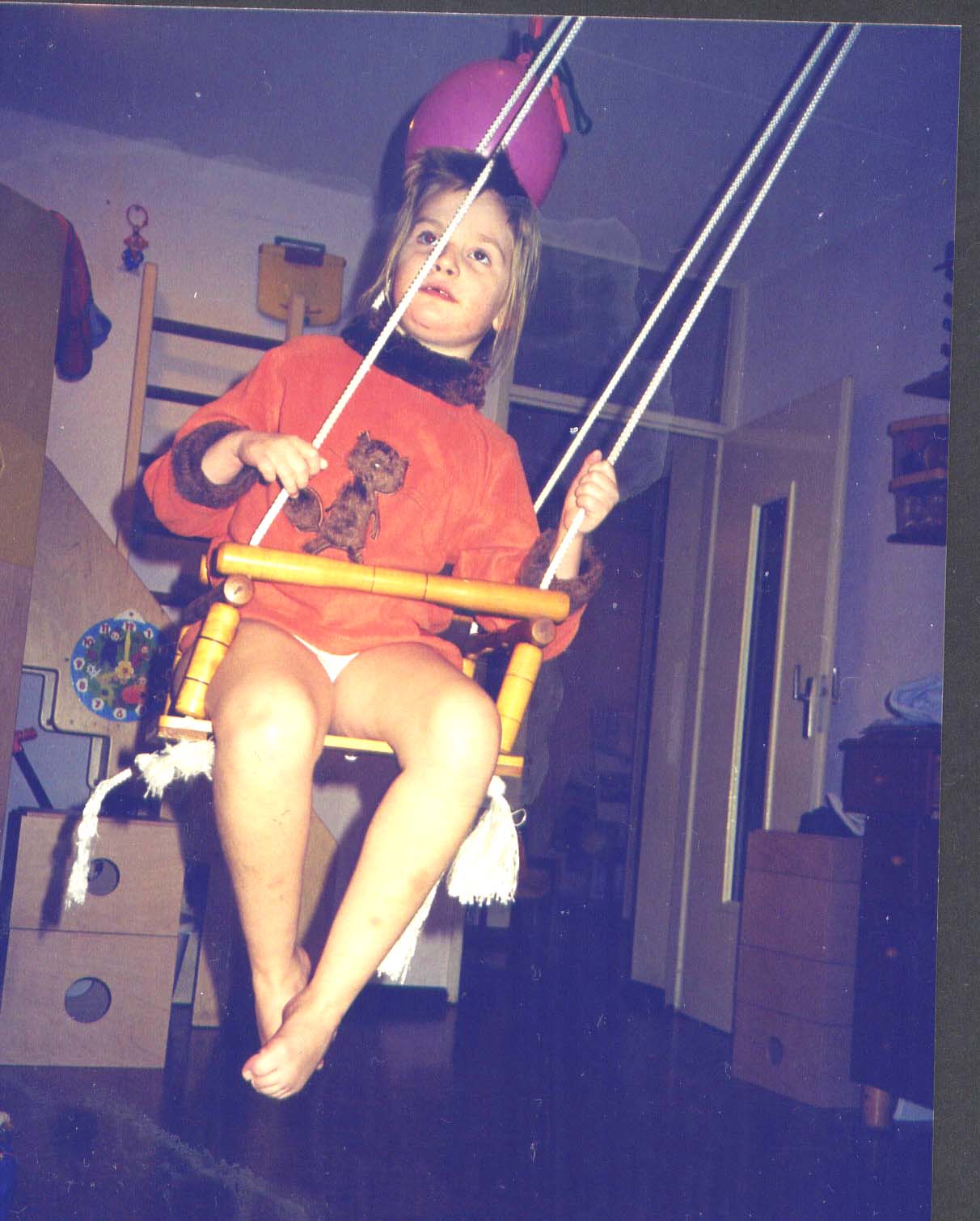
FOUR ASPECTS WHICH PROGRAMME COVERS
Since this is an extraordinary intensive training of different brain centres, then it is logical
it must be given ideal conditions in which it can receive information, memorize
them and use them later on. Therefore, the brain needs: optimal food and
sufficient oxygen. From this reason, the
programme includes, besides intensive, all day exercises, the following:
nutrition + breathing stimulation of which I am going to say something more
later on.
1 ___ BREATHING AND MASK
Excerpt from the programme:
“Of all the factors crucial to human life, breathing is one of the
most vital… Althoug the brain in a male adult represents only 2% of his
total body weight, it uses more than 30% of the total oxygen available. The
brain of a 5 year old child requiers even more – about 50%. Thus, oxygen
availability is a most important item for any human being. Some of our children
breathe very poorly. They take in less oxygen than a well child; their
breathing varies in both: depth and rhythm, and they are prone to colds and
respiratory infections. Because of posture problems and lack of function, their
chests are small and underdeveloped, and it is often a major effort for them to
breathe at all….
We know that function determines structure, and
that were it possible for the children to breath more deeply, and more often,
the dimensions of their chests would increase, thus producing a bigger
reservoir of available oxygen…. Deep breathing exercises, if carried out regularly,
are known to increase the breathing capacity, as well as improving individual
alerthness and efficiency. Unfortunately, many of our children are precluded by
their physical condition from carryng out such exercises, or their level of
understanding is too low to follow instructions. So we have to find another
way…. This way is MASKING!….
Many years ago, it was discovered that CO2 was an
excellent promoter of brain/blood circulation. In fact, it is probably the most
powerful of all blood vessel dilators. Within 30 seconds of the introduction of
extra CO2 into the system, there is a marked increase in blood circulation, and
thus improved oxygen availability…. An increase in the amount of CO2 present in
the bloodstream triggers of a requirement for more oxygen, and the brain’s
response is to require an increase in breathing rate….Put in its most simple
terms, masking has both a long term, and a short term effect. In the long term,
it helps to produce a bigger “tank” of available oxygen. In the short term, it
helps to increase the size of the “plumbing”!
Naturally, as with every technique we use with our
children, there are strict rules for masking. Before any child is masked, he
has a very thorough medical examination, and if Doctor finds any
contra-indications, the technique is not used…. In the last 25 years, masking procedures have been
employed with over 1400 children, and technique must have been used by parents
several milion times. There has never been one instance where a child was hurt
by this procedure.
Mask- Copyright Brain-Net 1996
We have done about 20 masks a day with Dejana and each one lasted exactly ONE minute. During the
period of two year exercising, there was no single problem, but we could
frequently notice that the mask reduced fatigue, and sometimes increased
concentration, particularly at the beginning – during the first couple of
months of the therapy. Dejana still has no problem with breathing, neither she
has hyperventilation, so characteristic for the Rett syndrome. We reduced the
use of mask, because Dejana could now breathe deeper during her activities. By
the way, at four checkups we had at the Alison Centre, her chest circumference
(and her lungs too) was developing well, and the percentage was even higher
than with a normal person of her age. Dejana used to bear the mask extremely
well, she did not refuse it, nor protested it, except in several occasions when
she was obviously not in the mood. Otherwise, the mask should be used very
carefully and must be removed the very moment a child shows a resistance, even
the slightest one. It should help a child, and not to be a burden, and should
be used only that way. (One of the photos shows how this exercise should look
like).
2 ___ NUTRITION
At the Brain-train Alicon Center, we learned that:
A- A good neurological environment cannot be obtained without a good nutritional environment.
Therefore one has to take very good care about the quality of the food.
B- A constant supply nutrients, through food and vitamin supplements, is necessary
because many of our children suffer from malabsorption (poor brain function).
C- Our children, and our parents, need additional diet supplements to cope with the added stress
of SUCH INTENSIVE programme.
We allso learned what good nutrition means: food that retains its natural value with nothing added and nothing taken away.
Unfortunately, nowadays the food that we buy, unless you can buy organic food, or grow your own, has been through a lot before it has reached our plates. Our meat is fed on antibiotics and hormones, our vegetables are sprayed with pesticides and chemicals, and artificially produced additives, preservatives and flavourings are added to make it look more tempting for sales. As a result food and chemical allergy or intolerance has become a primary cause in Western society. The most common allergens are: wheat; dairy products, sugar/chocolate, eggs, yeast, soy, corn, tea and coffie.
So What Is Good Food?
There are six main nutrients we have to consume every day:
carbohydrates, fats, proteins, vitamins, minerales and water,
which we need:
- to provide the body with heat and energy
- to provide the body with material for growth and repair
- to assist in regulating the body's processes
All red meat and NO fish or white meat (e.g. chicken) is NOT balanced.
All cereals and NO green vegetables is NOT balanced.
Too much of any one type of food is not balanced.
DO'S and DON'T'S
It is very important to:
- Follow a whole-food diet that is prescribed and trying to make NO exeptions
- Eat nothing to excess
- Supplement the diet with vitamin and mineral SUPPLEMENTS
- Avoid ALL processed foods
- Avoid any food containing E-numbers, flavourings and preservatives
- Avoid white sugar, white bread, processed cereals, sweetend soft drinks, saturated fatty acids
- EAT NATURAL FOODS
- Do not overcook vegetables. Important aspect to consider is how we treat our home grown or organic food once in the kitchen. Anything that happens to the food reduces its nutritional value - peeling, boiling, freezing, re-heating. The best way to retain nutrients in vegetables is steaming.
- Read the labels
- Eat breakfast like a King, lunch like a Lord, and supper like a commoner!
- Do not smoke in front of a children
- Do not use aluminium pans, or foil. It has been found that they leak aluminium into the food
which is been attributed to causing Alzheimer's disease.
Mask- Copyright Brain-Net 1996
DEVELOPMENT PROFILE
During the first days of our
visit an assessment of Dejana's possibilities was made. She was compared with
healthy peers during a number of tests. Her specific level of development for
each of the fields was noted and compared with the appropriate level of her
healthy peers. This resulted in a development profile for Dejana. This profile
includes different attainment levels in healthy children’s development from birth,
till six years old. Special emphasis is given to the three sensory - and three motor skills.
These include:
visual, auditory and tactile development, as well as mobility, language and
manual competence. It is possible that a child achieves a higher level in any of
the fields, but that it still misses basic steps from the early development.
For example: In auditory
development, Dejana was able to hear and understand single words, which is normal
for a child that is 12 months old, but at the same time she was not able to give the vital response to threatening sounds at all. To say it more simply:
she could hear words, but it looked like she did not hear the very loud noise
of a truck horn that was blown 1 meter from her ears. It was funny and strange
when they tested her in the play room with a sudden threatening loud sound of the horn so
hard that most of us were in shock, but she did not even blink with her eyes. It
was not because Dejana could not hear at all, but because her auditory brain
centre had not developed yet, she received sounds from her surrounding
selectively.
After 1 year of
exercise, she responded very well to loud and threatening noises. At the same
time, her responses to different sounds in her surrounding improved a
great deal, and
she started to be more curious when she was outside, which gave her lot of new opportunities
to discover the world of fun and sounds around her. She turned her head more and more to
see a cat miauwing, a dog barking, a bicycle bell ringing, children shouting…
etc, which stimulated her development even further. But, to turn back to the development profile!
When the tests on a child are completed, Keith’s team
filled in the table with the results. There were three grades in each
developmental level: perfect, imperfect and absent.
Perfect means that the child shows possibilities equal to her healthy peers.
Imperfect means that the child does respond, but not well enough,
and no matter how far she is, she
will get exercises in that field
to practice untill her results become perfect.
Absent means that the
child cannot do anything at all in the field.
The profile has 8 vertical
levels that include developmental growth from: birth day, three months, six
months, one year, one and half year, three years, six years and the general peer
level for children of 6 years old. On the left sides are tree columns that
include: Auditory, Visual and Tactile (for left and right hand) development.
They are called: SENSORY input. On the right side were also three columns:
Mobility, Language and Manual competence (for left and right hand). They are
called: MOTOR output.
In each of the
six columns there was one main achievement test for every stage of normal
development.
When Dejana got her own profile, completely
filled in, our long and hard climb could begin. We were given a set of exercises
to do two times a day, seven days a week, seven months in a row, before we would go to the Allison centre
for our next assessment. And that was not all. We got to
work out her new diet, a lot of single exercises and a great deal of advice and tips for
daily life.
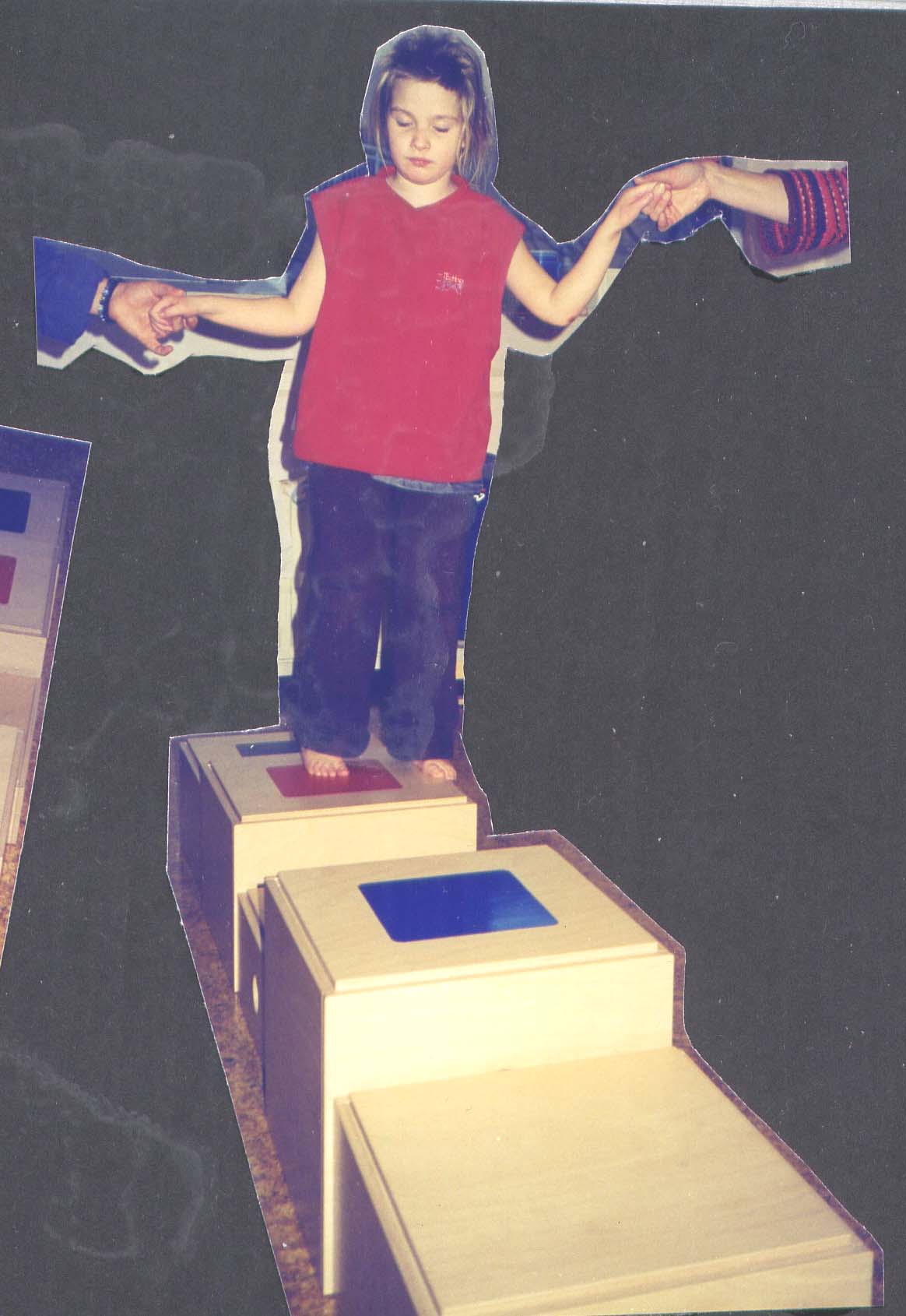
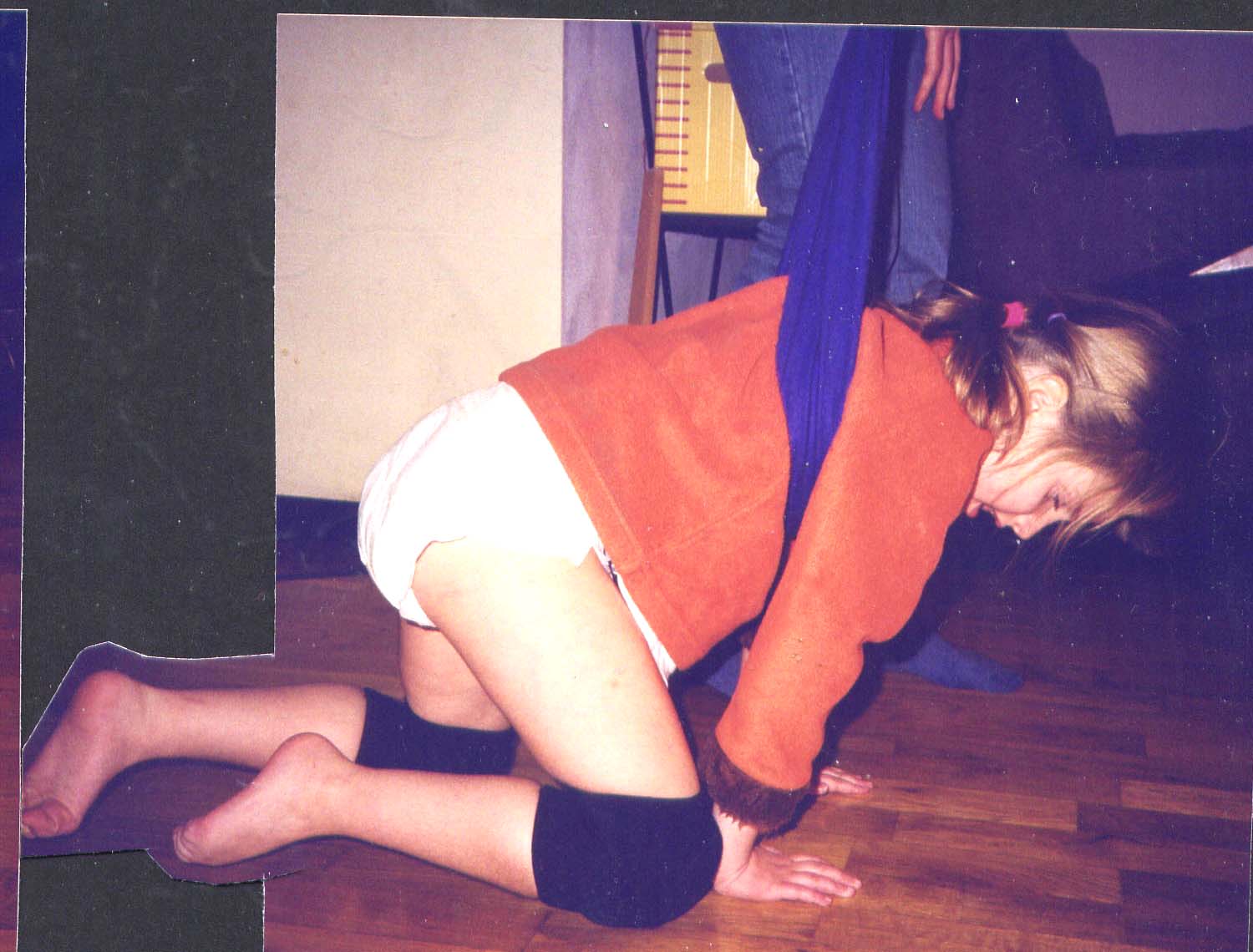
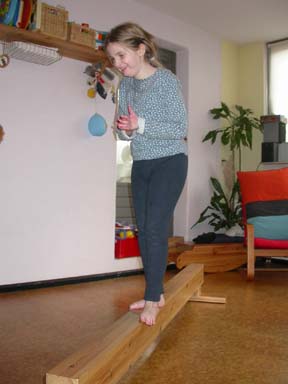
3 ___ PATTERNING
This is one of the most important parts of the programme. There are 4 kinds of
patterning. They cannot be mixed. Only after the child has mastered one kind
and has reached a higher level of gross motor skills the next variant can be
exercised. The excersises last 5 minutes, the child lays passively on her back
while we help her to rhythmically move her legs arms and head in the right
order and the right position (simulation of walking).
Below you find the exact description from the book “Brain Injured Children” by Keith
Pennock:
“Patterning
is a term we use to describe a series of physical movements carried out on many
of our children, by teams of up to 5 people. There are several different
movement patterns, and each is aimed at stimulating a different brain area, in
order to encourage different levels of co-ordinated movement. The choice of a
specific patterning technique depends on the needs of each individual child,
and is a primary tool in teaching the brain a particular function where this
has not yet developed or has been by-passed. All patterning is passive in
nature. The child is not required to do anything, as the whole principle of the
activity is to present a series of related bits of information to his brain for
storage… As a technique patterning offers several additional benefits which
are extremely important to some of our children:
- it enhances tactility, and thus body and limb awareness
- at higher levels, it improves balance through the regular stimulation given to the
inner ear by turning of the head
- it can give visual stimulation, when targets are placed on each side of the table
Patterning is designed to teach the brain how it feels to move in a variety of
different ways.
Copyright Brain-Net 1996
HOMOLATERAL Patterning (duration five minutes)
We did
it two times a day, seven days a week, 15 minutes long.
We placed Dejana face down on a padded table with minimum clothing and without
socks. Than we started with bending the right elbow and knee at right angles,
while the left arm and leg was straight. The head was turned to face the bent
arm. As a head was turned to face the other direction, the bent limbs were
straightened, and the straight limbs bent. The two positions were alternated,
taking the speed and rhythm from the head. RHYTHM is more important than speed.
Aim of that exercise is to:
- give the brain information about basic movement at the Pons level
- increase tactile awareness
- encourage the maturation of an immature tonic neck reflex
“Homolateral Patterning is designed for a child that has sufficient movement in his limbs,but cannot creep forwards on his tummy. In this way we can teach him how it feelsto do so… If viewed from above during Patterning, the child appears to be
creeping forwards in a movement pattern similar to that of the amphibian, using
one side of his body to propel himself forwards, than the other. It is the pons
area of the brain which is responsible for controlling the ability to creep on
the tummy.
Copyright Brain-Net 1996
CROSS Patterning (duration five minutes)
We did it two times a day, seven days a week, 15 minutes long.
We placed Dejana face down on a padded table with minimum clothing and without
socks. The movements were done slowly and rhythmically.
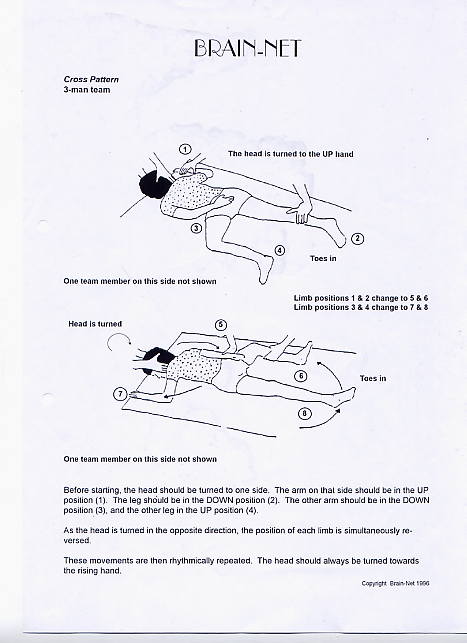
Aim of that exercise is to:
- mature the asymmetrical tonic neck reflex (ATNR) into the transformed tonic
neck reflex (TTNR)
- improve head control and position
“The highest brain levels which we believe can be stimulated by patterning are the
mid-brain and cerebral cortex, and these control, respectively, crawling on
hands and knees, and walking. Cross Patterning represents a more sophisticated
form of prone patterning where, instead of moving one whole side of the body at
a time, helpers move opposite arms and legs in synchronisation with a head. The
brain is now able to co-ordinate each individual limb, rather than just one
side of the body at a time, and has developed sufficient awareness of space…”
Copyright Brain-Net 1996
4 ___ EXERCISES and INTELLIGENCE PROGRAM
**** TACTILE STIMULATIONS ****
Tactiles A,B,C over the whole BODY (duration five minutes)
We did it three times a day, seven days a week for two years, and we are stil doing it. We applied Tactiles A-B-C to her arms, legs and trunk and we always worked from the extremities of the body towards the trunk, and from the lower end of the trunk towards the head.
Tactile A:
Applying a vibrating massager, using a different attachment each time. We told her always what the sensation will be and which part of the body we are stimilating.
Tactile B:
We used sofy and rough materials (silk - denim… leather - wool… cotton - tweed… carpet - fleece… baby's brush - nail brush etc). We first stroked the area with soft materials, than rubed it firmly rough material.
Tactile C:
Apply cold, than hot alternately to each area, always finishing with hot. IMPORTANT: A child's skin can be burned by both extreme temperature and by friction. It can also be burned even if she cannot feel it. Therefore always use a cover over both cold and hot stimuli.
Bath Time:
We rubbed all over her body with bath brush or loofah and than dried vigorously with a rough towel, telling her what we are doing.
The aim of these tchniques are:
- to increase tactile awareness over the whole body
- to increase overall proprioception
Tactiles A,B,C to HANDS (duration two minutes)
We did it 18 times a day, seven days a week for two years, and we are stil doing it partly.
TactileA:
We applied a vibrating massager with a variety of heads (an electric toothbrush would be very appropriate) to the palms, backs and individual fingers of her hands. We used a different attachment each session and told her what the sensation will be. Make shure that all areas of the hands are stimulated during the session.
Tactile B:
We used a variety of different materials, each of which having a distinctive 'feel' of its own. We rubbed her hands with the chosen texture, telling her at the same time what the feeling is. It is important to use two contrasting materials per session (silk - denim… leather - wool… cotton - tweed… carpet - fleece)
Tactile C:
We applied cold, than hot alternately to the palms and backs of her hands and fingers and thumbs, either by using cold and hot packs, or bowls of cold and hot water. It is important to finish always with hot.
The aim of these tchniques are:
- to increase tactile awareness in the hands
- to increase manual proprioception
Tactiles stimulation to the MOUTH (duration two minutes)
We did it 14 times a day, seven days a week for two years, and we are stil doing it partly.
To provide the child with tactile stimulation to her mouth we used:
1. An electric toothbrush, immersed in a suitable solution to provide sensory stimulation to her mouth by brushing the teeth and gumes, cheeks, palate and lightly her tongue
2. An ice cubes (frozen water lolly), provides stimulation to the inside of the mouth and lips
3. A spray bottle (set on its widest setting) sending a fine spray of cold/warm/hot water into the mouth
4. A spray bottle, empty of water can blow air into her mouth
The aim of these tchniques are:
- to improve tactile awareness in the area of the mouth
- to improve chewing
- to help articulation
Tactiles stimulation to the LIPS and TONGUE (duration two minutes)
We did it fore times a day, seven days a week for two years, and we are stil doing it entensievly.
To provide the child with tactile stimulation to her lips and tongue we:
1. Encouraged Dejana to blow a mouth organ, a recorder, or a whistle
2. Encouraged her to blow out a candel through a wide plastic straw in the beginning
3. Encouraged her to blow bubbles ( a pot of bubble mixture) through a wide plastic straw
4. Encouraged Dejana to suck and/or blow through a large straw in the pot with water
The aim of these tchniques are:
- to improve the manipulative abilities of tongue and lips
- to improve articulation (we stimulated her speech)
Tactiles stimulation to the LIPS and TONGUE - Extended (duration two minutes)
We did it fore times a day, seven days a week for two years, and we are stil doing it.
To provide the child with tactole stimulation to her lips and tongue we:
1. Encouraged Dejana to open and shuit the mouth
2. Encouraged her to stick her tongue out and than in again
3. Encouraged her to lick a lolly
4. Encouraged her to pucker the lips to kiss
The aim of these tchniques are:
- to improve manipilative abilitates of the tongue
- to improve articulation
Material stroking (duration one minute)
We did it three times a day, seven days a week for one year. We placed Dejana to sit
at the table, the surface of which is covered with different textured
materials. Somebody stood behind her, and placed his left hand over her left
hand, layed her hand on one strip of textured material and stroked it from top
to bottom. We repeated it for 30 seconds, and than did the same with her right
hand. Aim of that exercise is to:
- give tactile sensation to the hand
- open her fingers
- straighten the wrist
Gustatory technique
At least tree times per day we gave Dejana an opportunity to taste something which is strongly flavored and we always told her the name of the substance which she has to taste. Examples of foodstuffs which possess a strong taste are: mustard, curry powder, hony, garlic, cinnamon, salt, vanilla essence, vinegar, lemon juice, molasses, pepermint oil (tei) celery salt, pepper.
Aim of that excersise is to:
- improve the sense of taste
- improve tactile awareness in the mouth area
- teach her the names of various tastes
- reduce dribbling
- improve chewing
- improve articulation
Olfactory technique
At least tree times per day, for 10 seconds, we allowed Dejana to smell a substance, whose aroma was reasonably strong. Each substance should be kept in a tightly sealed bottle or jar, and when opened should be immediately placed under child's nose for 10 sconds. It is importetn to tell her what it is that we are giving her to smel. Examples of substances with strong smells are:
perfume, nutmeg, aniseed, dill, garlic, vanilla essence, orange, peppermint oil, pepper, mustard, almond oil, citronella oil, vineger, lemon juice, rosemary, camphor, coriander, fennel…
Aim of that excersise is to:
- improve the sense of smell
- increase child's sensory awareness
- teach her the names of various smells
- stimulate the brain
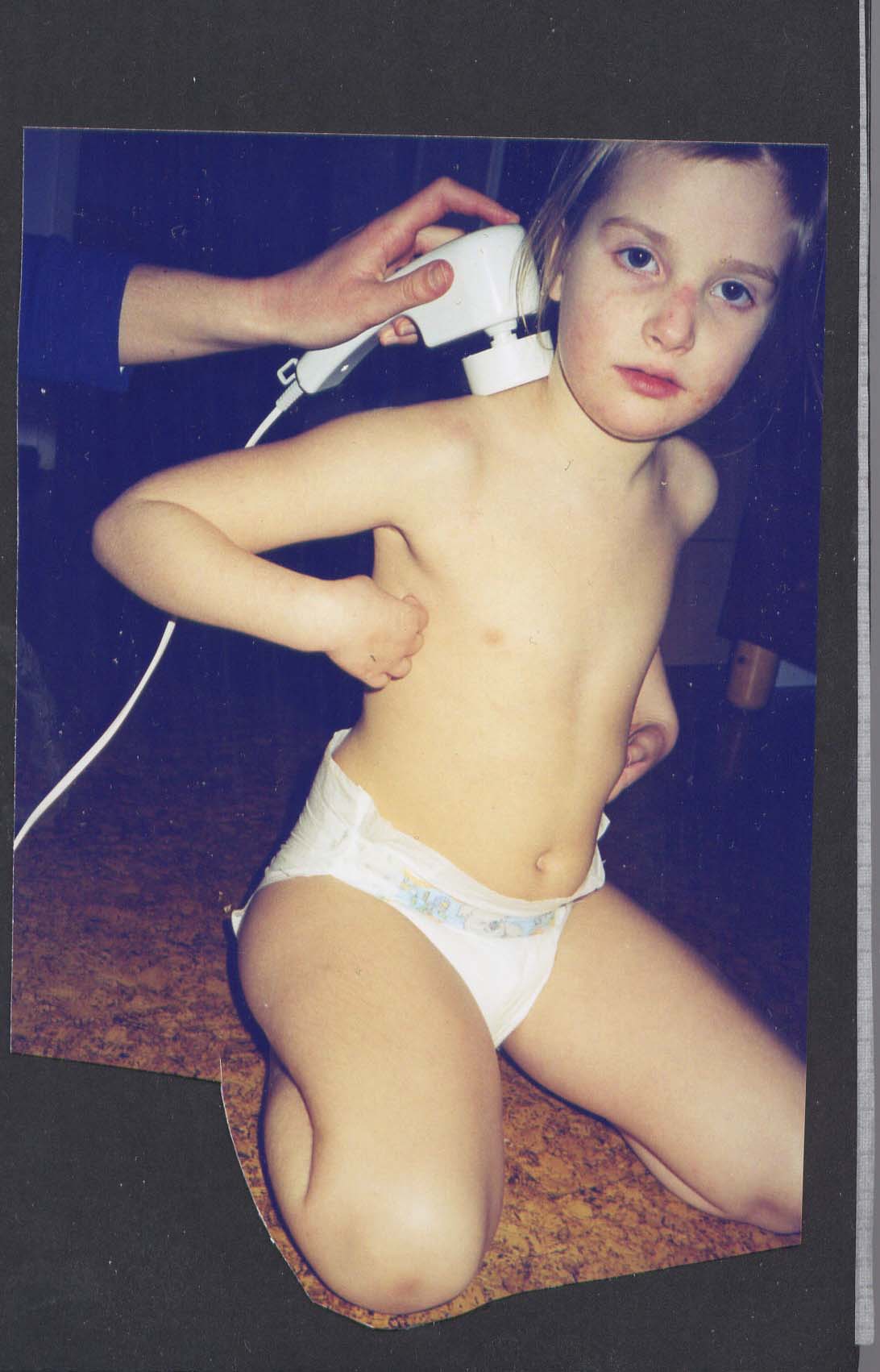
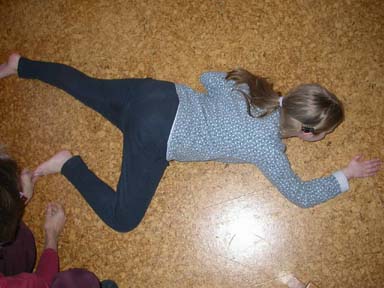
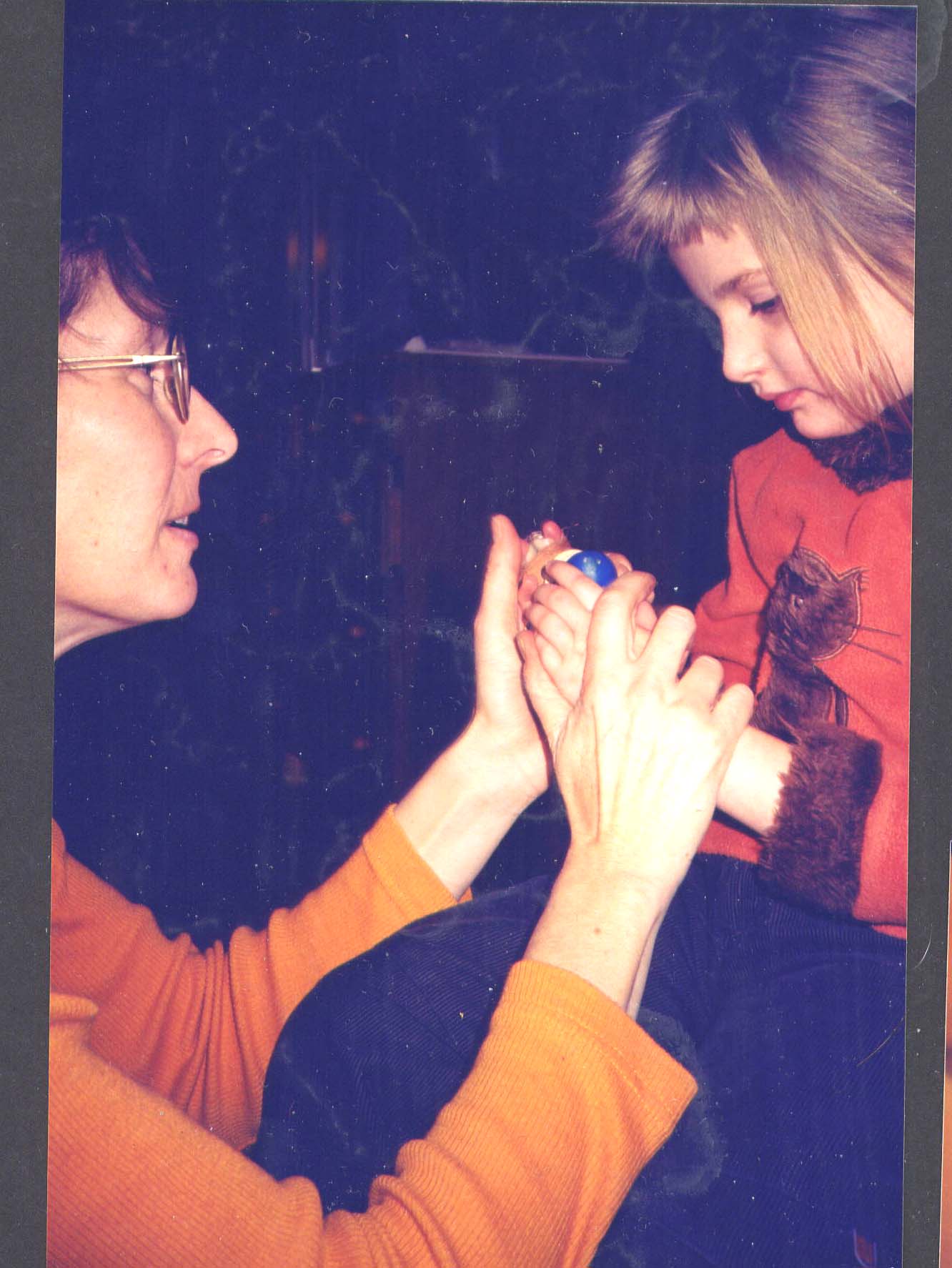
**** STIMULATION OF THE SENSORS for SIGHT and HEARING ****
Basic vision (duration one minute)
We did it 5 times per day 15 months long in the completely darkened toilet room.
Dejana was sitting while we held a flashlight 30 cm from her face shined the
torch into her one eye for ONE second. Than we turned off the torch for a count
of 5 seconds. It was repeated 5 times, and than 5 more times with the other
eye. The objectives of these techniques are:
- to improve the reflexive responses to light and dark
- to stimulate the optic nerve
- to reinforce vision at higher levels
**** GROSS MOTOR SKILLS ****
No “W” sitting
Assisted Creep (duration five minutes)
We did it three times a day, seven days a week, and we are still doing it. Dejana was
placed in a prone position on the floor and encouraged, both verbally and
physically, to move forward on the abdomen. The legs were moved alternately
into the correct position, with hand placed on sole of each raised foot to
assist forward movement. A ramp may be used to encourage creeping. Aim of
that exercise is to:
- give opportunity for co-ordinated movement with assistance, at the pons level
- improve visual convergence
Assisted crawling / truck + trailer (duration 3 toward 5 minutes)
We did it three times a day, seven days a week, and we are still doing it but on much
more sophisticated way. In the beginning, we encouraged Dejana to crawl on her
hands and knees with much supporting by placing a sling or towel around her
waist to hold her in the quad position. Aim was to have her crawling
independently as soon as possible. In the first few mounts, she needed one
helper in front of her to help her move her hands forwards and one behind to
keep her legs moving. When she started to crawl independently, the person
behind continued to hold her ankles to ensure that the top of her feet stayed
flat on the floor, and to provide a little resistance to her crawling, but not
enough to make her stop. Aim of that exercise is to:
- aid the maturation of the tonic neck reflex
- improve crawling
- provide opportunity for mobility at the mid-brain level
- improve balance and co-ordination
- improve visual convergence
- encourage hand-eye coordination
Quard rocks (duration one minute)
We did it three times a day, seven days a week, 15 mounts long. Dejana was placed in
the quad position on hands and knees so that we could have rocked her back in
the sitting position on her feet, but with her hands still on the floor, and
than forward again into the quad start position. We continued rocking her for
one minute long. Aim of that exercise is to:
- mature an immature symmetric tonic neck reflex
- improve convergence
Hang by hands (duration one minute)
We did it two times a day and we still work on it today. Dejana is encouraged to hold
a D-rings which have been attached to a hoist. We pull her up from standing and
hang her so that her feet are 10 cm from the floor. We still need to hold her
hands on the rings, because she can not hold her own weight for more than
several seconds. Aim of that exercise is to:
- improve grip
- strengthen and to stretch arms
- improve spatial awareness
- straighten her back
Arm and leg swings (duration two minutes)
We did it two times a day, seven days a week 6 months long. Exercise was done with two
people holding an arm and a leg each, swinging Dejana forwards and backwards
for one minute. Than with one person holding both arms and one person both
legs, swinging Dejana from side to side for one minute. Aim of the exercise is to:
- improve spatial awareness
- give the child some fun and she really DID enjoyed in it!
Hang by legs (duration one minute)
We did it two times a day, seven days a week 6 months long. With two people, grasped
Dejana firmly by each ankle and hanged her upside down. Once she is accustomed
to being in this position, we gently swing her backwards and forwards,
gradually increasing the speed and length of swing. Aim of the exercise is to:
- increase spatial awareness
- improve the balance
- encourage convergence
Stepping stones (duration two minutes)
We did it two times a day, seven days a week, and we still work on it today.
Using wooden boxes of different heights and colours, or numbered, we encouraged
Dejana to walk from one to the other. At first, we placed stepping stones next
to each other, but when confidence has been gained, we gradually increased the
distance between each, varying the heights. We regularly changed the lay out
and pattern of the boxes to keep her interest. The aim of the exercise is to:
- increase balance and co-ordination
- increase confidence
- improve depth perception
Inclined ladder (duration five minutes)
We did it two times a day and we still work on it today. A ladder was placed at a
fairly steep angle against the wall and good fixed on it. We encouraged Dejana
to climb the ladder with hands and feet in contact with the rungs, using a
cross pattern movement. She also climbed back down and she got as much or as
little assistance as SHE required, however we worked towards her independency.
The aim of the exercise is to:
- develop the ability to move in a cross pattern
- improve balance and co-ordination
- increase confidence
- strengthen leg muscles
- encourage the legs to move independently of each other
Walking with stimulation of running
Swimming
**** FINE MOTOR SKILLS ****
Manuals
-tactile to hands
-object in hands
**** BALANCE ****
Rolls (duration 2 minutes)
We did it three times a day, seven days a week, 15 mounts long. Dejana was placed flat
on the floor, on her back; we rolled her over and over, first in one direction
and than in the other with her arms stretched above her head. The technique was
applied gently at firs, but later we did it with increased vigour Dejana become
accustomed to the sensation. The aim of the exercise is to:
- increase spatial awareness
- improve balance
- improve proprioception
Garden swing (duration 3 minutes)
We did it two times a day, seven days a week, two years long. Dejana was placed in the
save wooden swing suspended from the ceiling in her room. We swung and spinned
her gently at first with increasing vigour as she become accustomed
to the sensation. The aim of the exercise is to:
- increase spatial awareness
- improve balance and coordination
Balance beam (duration 2 minutes)
We did it two times a day; seven days a week and we still exercise it. We stood behind
Dejana, holding her both hands, facing in the same direction as her and with
both her feet on the beam. We walked together, giving her support when
required, and she learned to walk first forwards, and later on backwards.
The aim of the exercise is to:
- challenge balance and co-ordination
- increase self-confidence
- improve depth perception